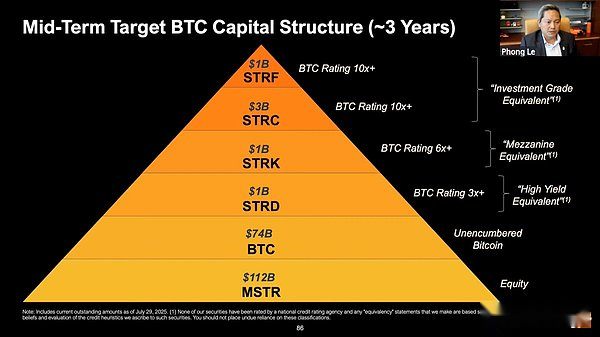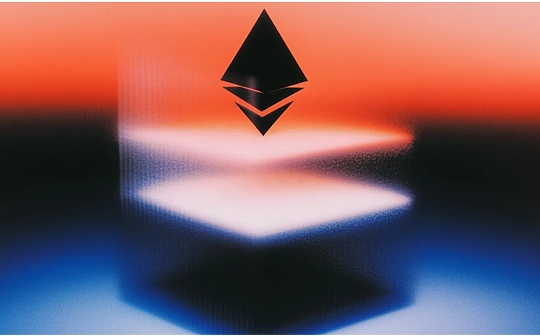
Source: TokenInsight, compiled by Shaw bitchain vision
summary
-
Multi-layer capital structure serves Bitcoin acquisition strategy: Strategy (formerly MicroStrategy) constructs a multi-layer capital structure composed of common stocks, convertible bonds and a variety of preferred stocks (such as STRK, STRF, STRD, STRC), providing funds for large-scale holdings of Bitcoin.The risks and returns of tools at different levels vary, meeting the needs of different investors.
-
Design and positioning of STRC: The newly launched STRC (Stretch) is a stable preferred stock supported by Bitcoin. It has an annualized return of about 9%, pays dividends on a monthly basis, and keeps the price close to the face value of US$100 through flexible adjustments to dividend yields, redemption mechanisms, etc.It is located in the middle of the capital structure, with volatility lower than high-risk preferred stocks, and its returns higher than traditional cash equivalents, making it suitable for investors who pursue stable returns and want to indirectly participate in Bitcoin price changes.
-
Sources of funds and potential risks of dividends and interest: The company plans to pay preferred stock dividends and debt interest through software business cash flow, newly issued bonds or convertible bonds, and “issuance at market price” (ATM) common stock.Although this model is sustainable when the market is optimistic, if the capital market tightens or the stock price falls sharply, financing capabilities will be limited and dividend payments may face pressure.
introduce
Strategy (formerly MicroStrategy) has carefully crafted a unique capital structure that combines a variety of debt and equity instruments to fund its operations and the most eye-catching Bitcoin acquisition.In short, capital structure refers to the debt and equity combinations used by a company to raise growth.Strategy’s case is particularly striking as it introduces a variety of innovative financial instruments, including common stocks, preferred stocks such as STRK and STRF, convertible bonds, and now the newly launched STRC.
The latest STRC (Stretch) is particularly eye-catching.STRC is advertised as a “stable” Bitcoin-backed stock designed to mimic the stability of U.S. Treasury bonds, providing a low-volatility, cash-like earning layer in Strategy’s BTC credit stack.
This article will break down these layers in simple terms, explaining what STRK, STRF, and STRC are and how they work.
Capital structure foundation
Think of a company’s financial situation as a multi-layer cake or pyramid.Each layer represents a different type of capital, each with risks and rewards:
-
Priority debt (loan/bond)——This is the top level of debt (imagine first class or first cake on the plane).Debt investors (such as bondholders) have priority.They borrow from the company and expect to receive interest.If a company goes bankrupt, these creditors must be repaid before shareholders receive any gains.Debts are usually less risky (secured by assets or preferred claims), but earnings (interest) are fixed and limited.
-
Preferred shares (preferred shares)——In the capital structure, preferred stocks are between debt and common stocks.Preferred stocks are like a mixture: they usually pay a fixed dividend (similar interest) and get paid in advance over common stocks, but usually have no voting rights.For example, preferred stock investors are like a “priority” boarding group-the priority is not as priority as first class (debt), but their boarding takes precedence over economy class (common equity).The return of preferred stocks is more predictable (fixed dividend), and the price tends to be more stable than that of common stocks, but if the company’s value soars, its room for upwards is usually less.Importantly, if the company is liquidated, the preferred stock holder has the right to obtain its funds (maximum amount) before the common stock shareholder.
-
Common Stock (Equity)——This is the bottom layer of the cake (or the last one to board the plane).Common shareholders are the owners of the company.After all other obligations are fulfilled, they acquire the remaining shares.This means the highest risk (in the case of bankruptcy, common stocks usually get nothing), but also the highest potential return (if the company thrives, common stock prices may soar, with no upper limit).Common stock shareholders usually have the right to vote and get the most from long-term growth, but they are last in claiming assets or cash flow.
In short, the capital structure is hierarchical:Debt>Preferred Stock>Common Stock(Sorted by creditor’s priority).Each layer has different risk/reward characteristics and is suitable for different investors.Now, let’s see how Strategy uses these elements to build its own capital structure.
Strategy Overview of Overall Capital Structure
Strategy has carefully designed a multi-level capital structure to support its strategy of increasing its Bitcoin stake.As of 2025, the company’s capital structure includes:
Common stocks——Strategy common stock traded under the MSTR code on Nasdaq.These common stocks are aimed at shareholders who want to directly participate in the fate of the company (and hold Bitcoin).
Preferred stocks——Permanent preferred stocks in multiple series, creative nicknames:
-
STRK (“Strike”)——8.00% Series A permanent preferred shares issued in early 2025.
-
STRF (“Strife”)——10.00% Series A permanent preferred shares issued in March 2025.
-
STRC (“Stretch”)——A tool with an annual rate of return of 9%.STRC provides stable, low volatility, cash-like investment options.
-
STRD (“Stride”)——High-yield sub-preferred stocks have higher risks and returns than other series.STRD is designed for investors looking for higher returns and higher risk.
Convertible bonds——This type of debt instrument can be converted into common stock when the Strategy stock price reaches a certain level.Strategy has issued several convertible bonds, notably the 0% interest rate convertible bonds due in the next few years (2027, 2028, 2030, etc.), aiming to raise billions of dollars in funding to buy Bitcoin.

Source: Strategy
Each layer can be viewed as a different way for investors to bet on Bitcoin in a way that suits them:
-
Common Stock (MSTR) – Suitable for investors looking to gain the maximum upside (or downside) that is pegged to the price of Bitcoin, as the value of the stock is largely driven by the value of Strategy’s Bitcoin holdings.
-
Preferred stocks (such as STRK, STRF) – suitable for investors who want income (returns) and certain stability, effectively obtain fixed returns without directly owning the full volatility of Bitcoin.
-
Convertible Bonds – For investors who want both bond security (priority claim and repayment commitment) and Bitcoin rising call options (convert to stocks if stocks soar).
STRC: Strategy, cash-like layer in the capital structure
STRC, or “Stretch” is the latest innovation in Strategy’s capital structure.STRC is aFloating interest rates, permanent preferred stocks, provides investors with stable high-yield investment opportunities backed by Bitcoin.The tool’s functionality is similar to cash equivalents, providing low volatility and regular monthly dividends while still allowing investors to invest in Bitcoin’s performance.
Preferred stock is a special type of stock that has a fixed dividend and takes precedence over common stock in terms of obtaining dividends or assets, but usually has no voting rights.Strategy’s preferred shares are “permanent”, meaning they have no expiration date (the company is not obliged to repay principal; it pays dividends indefinitely unless the shares are redeemed).

Key Features of STRC
Yield and dividends: STRC provides an annual dividend yield of approximately 9%, paid monthly.The dividend yield is adjustable monthly and aims to keep the share price near its $100 list price.STRC is an attractive option for investors who focus on returns, seek stable cash flow without having to withstand the huge volatility of holding Bitcoin directly.
Price stability mechanism:
-
Monthly interest rate adjustment: To keep the price stable, Strategy has the right to adjust the dividend yield monthly to ensure that the price of STRC remains around $100.If the price is below the face value, Strategy will increase the dividend; if the price rises, Strategy will lower the dividend and issue additional shares to bring the price back to the target level.
-
Issuer Call Options: If the STRC trades well above its face value, the strategy can redeem the stock at $101, plus accrued dividends, providing an additional mechanism to keep the price stable within the target range.
STRC in capital structure
In Strategy’s multi-layer capital structure, STRC is at the middle level.Its priority is higher than STRD (“Stride”) and STRK (“Strike”), but lower than STRF (“Strife”) and corporate debt.This positioning makes it a more stable and less volatile option than high-risk preferred stocks, while still providing a higher yield than traditional cash equivalents.
STRC is designed for investors of all types:
-
Credit InvestorsSeek low-volatility, short-term tools related to Bitcoin’s uptrend.
-
Cash ManagerI hope to obtain predictable stable returns, but I don’t want to be affected by the overall volatility of Bitcoin.
-
Those who are not willing to hold original Bitcoin but want to understand their price movements through stable cash-like toolsInstitutions and allocators.
How does Strategy fund dividends and interest?
It is worth reiterating that the company’s debt repayment plan.Strategy publicly stated that it will pay dividends and interest on preferred stocks and any debts using multiple sources: operating cash flow (from a software business that contributes millions of dollars in revenue), earnings from new or convertible bonds, and earnings from sales of common stocks (market issuance).
From 2023 to 2025, the company actively launched an ATM equity plan to sell a small amount of MSTR stock to the market—for example, it raised $500 million in 2023 and was authorized to sell up to $3.57 billion in common stock in early 2025.It’s a considerable amount of money: by gradually issuing new common stock (especially when the stock price is high), they can raise cash to pay dividends.
In addition, the launch of a new preferred stock series (such as STRD “Stride”) is explicitly intended to raise funds, partly for paying dividends from STRF and STRK.It looks like paying another one with one credit card – in a sense, it’s a refinancing program.It works as long as new investors are willing to join (and Bitcoin maintains strong momentum).If the capital market freezes or the stock price plummets, it will be much more difficult for Strategy to raise new funds, and that’s where its pressure appears.






